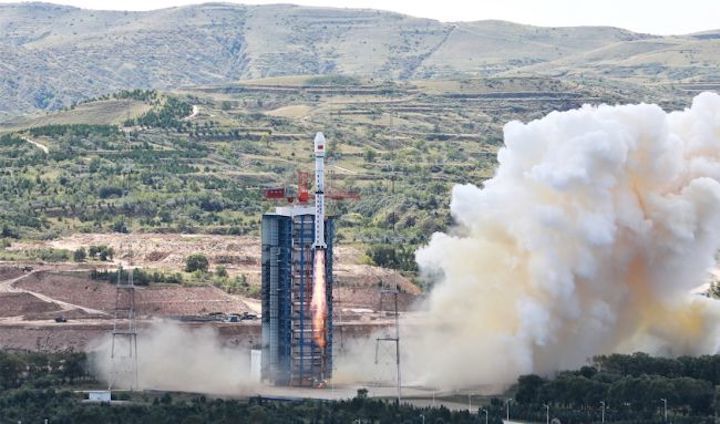7.09.2020

China launched a new optical remote-sensing satellite from the Taiyuan Satellite Launch Center in northern Shanxi Province on Monday.
The Gaofen-11 02 satellite was launched by a Long March-4B rocket at 1:57 p.m. (Beijing Time), according to the center. It was the 345th flight mission by a Long March carrier rocket.
Gaofen-11 02 has a resolution up to the sub-meter level. It will be mainly used for land surveys, city planning, land rights confirmation, road network design, crop yield estimation and disaster prevention and mitigation.
The newly launched satellite will also offer information support for the Belt and Road construction.
Together with the Gaofen-11 01 satellite, which was launched in 2018, Gaofen-11 02 will form an in-orbit network to improve the country's satellite observation efficiency.
The Long March-4B is a three-stage liquid-fueled rocket developed by the Shanghai Academy of Spaceflight Technology, affiliated to the China Aerospace Science and Technology Corporation. It has the ability to launch single and multiple satellites with different orbital requirements.
Monday's launch is the third mission of the Long March-4 series of carrier rockets this year. According to the rocket developer, 2020 will see several launches of the rocket model. Enditem
Quelle: Xinhua
----
Update: 8.09.2020
.
Chinese rocket booster appears to crash near school during Gaofen 11 satellite launch

China is expanding its constellation of Earth observation satellites.
A Chinese Long March 4B rocket successfully launched a new Earth-watching satellite Monday (Sep. 7) but the booster's spent first stage narrowly missed a school when it fell back to Earth, witness videos show.
The Long March 4B rocket lifted off from the Taiyuan Satellite Launch Center in north China, at 1:57 p.m. local time (1:57 a.m. EDT, 0557 GMT). It carried the powerful Gaofen 11 (02) Earth observation satellite, an optical observation satellite capable of returning high resolution images, showing features as smaller than 3 feet (1 meter) across.
Data returned by the Gaofen satellite will be mainly used for land surveys, city planning, land rights confirmation, road network design, crop yield estimation and disaster prevention and mitigation, according to Chinese media.
Gaofen 11 (02) will also offer information support for the Belt and Road construction, according to Xinhua. It will join a larger suite of Gaofen and other Earth-observing satellites as part of the China High-resolution Earth Observation System (CHEOS).
Few details of the satellite were made available. Footage of the launch of the first Gaofen 11 in 2018 indicated the satellite was a large aperture telescope for Earth observation.
Amateur footage posted on Chinese social media site Weibo following the launch apparently shows the first stage of the Long March 4B falling to Earth and exploding into a cloud of orange smoke. The footage was captured near the Lilong village, Gaoyao Town in the Luonan county of Shaanxi province, according to its author.
One piece of footage appears to be taken from a school yard with children’s voices audible and a plume of smoke visible in the distance.
The Long March 4B first stage uses a mix of toxic hydrazine and nitrogen tetroxide for propellant. Contact with either could bring serious effects on health.
China has three space launch sites situated deep inland, with their locations chosen to provide security during the Cold War. A new coastal launch site at Wenchang is limited to launching new Long March 5 and 7 rockets.
Launches from Xichang often see rocket debris fall near inhabited areas. Those areas calculated to be potentially threatened are warned and evacuated ahead of launch. The incident on Monday suggests fewer precautions were taken, though the emergence of footage also suggests locals may have been expecting activity.
The China Aerospace Science and Technology Corporation (CASC) developed and manufactured the Gaofen 11 (02) satellite. Shanghai Academy of Spaceflight Technology (SAST), one of the major institutes under CASC, manufactured the two-stage Long March 4B rocket. The corporation's main rocket-manufacturing facilities are in Beijing and Shanghai.
Today’s launch was China’s 25th so far in 2020, including a test flight of the Long March 5B for space-station missions and the launch of the Tianwen-1—the country’s first independent interplanetary mission. Three of the 25 launches ended in failure.
China’s main state-owned space contractor said in January it would aim for around 40 launches in 2020, with commercial launch service providers additionally carrying out their own missions.
Quelle: SC
